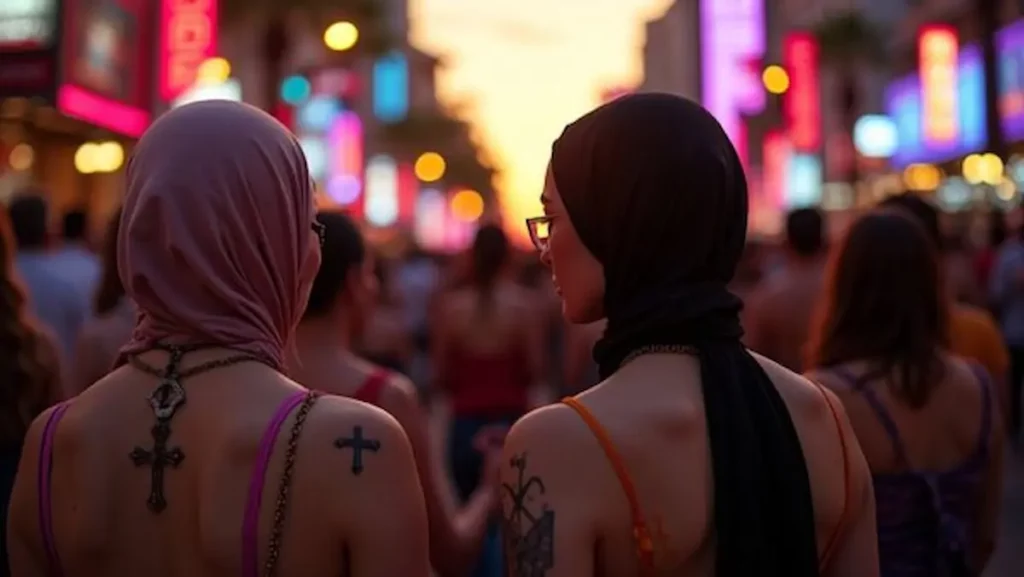
How religion influence fashion?
One of the most fascinating ways culture shapes style is through religion’s influence on fashion, revealing deep meanings behind what we wear every day.

Religion has long influenced culture, showing up in music, film, fashion, and social media. Today, its presence in pop culture is more visible than ever, but what drives these spiritual themes to resonate so strongly now?

Religious influence in pop culture runs deep, shaping stories, symbols, and traditions that people still recognize today. From spiritual leaders and sacred texts to ancient rituals, religion helped form the values and narratives that guide communities.
Through cultural exchange and interfaith collaboration, religious festivals evolved and spread, bringing new ideas into mainstream entertainment. Mythology, theology, and faith-based movements continue to inspire music, film, fashion, and art, showing how religious influence in pop culture remains powerful, relevant, and timeless.
This ongoing religious influence in pop culture highlights the lasting connection between spirituality and everyday life.
Religious symbols in fashion and design are becoming more visible, blending spirituality with style in meaningful ways. Many brands use religious symbols and sacred geometry to create pieces that honor devotional art and contemporary rituals.
At the same time, ethical fashion practices matter: designers should avoid cultural appropriation by researching the origins of religious symbols, engaging with communities, and crediting traditions respectfully.
When used with care, religious symbols can inspire mindful design, celebrate diverse beliefs, and connect pop culture with spiritual values.
Gospel and spiritual music have shaped many mainstream music genres in powerful ways. These traditions bring soulful vocals, emotional depth, and meaningful lyrics that speak about faith, hope, and healing.
Through gospel collaborations and spiritual music influences, artists blend styles and cultures, creating fresh sounds that resonate with wide audiences. This evolution inspires songwriters, strengthens community connections, and helps spiritual music gain lasting mainstream acceptance.
As a result, gospel influences continue to guide popular music, showing how spiritual music can uplift listeners and keep faith-centered stories at the heart of modern music.
Depictions of religious themes in film and television reveal how religion shapes characters, drives plots, and sparks cultural conversations. In many stories, religion guides moral choices, influences theological character arcs, and frames conflicts around faith, doubt, and redemption.
Directors use spiritual symbolism and sacred narratives to explore divine intervention, ritual practices, and belief systems, while audiences debate cultural appropriation and authenticity.
As the genre evolves, religion in film and television continues to inspire reflection, critique, and community dialogue, showing how spirituality, religion, and popular culture intersect in powerful and enduring ways.
Mythology and sacred texts shape storytelling in powerful ways across cultures and eras. These timeless sources from religion and spirituality offer rich archetypes, moral lessons, and symbolic journeys that guide how stories are told.
Through sacred narratives, creators draw on spiritual symbolism and religious motifs to craft plots, characters, and conflicts that feel universal. As these traditions are retold and adapted, they keep inspiring new works, showing how religion, spirituality, and mythology continue to influence storytelling today.
Religious art has a powerful impact on contemporary visual media, shaping how stories are told and how images are designed. Through sacred symbolism and religious iconography, religious art inspires filmmakers, designers, and digital creators to explore faith, identity, and meaning.
These faith-based narratives and transcendental themes show how religious art continues to guide visual storytelling, reinforce cultural roots, and bring spiritual aesthetics into modern media. By blending tradition with innovation, religious art keeps influencing contemporary visual media across film, advertising, gaming, and social platforms.
Today, religious influencers share viral content that builds digital spirituality and creates vibrant online faith communities. Through faith-based hashtags, religious memes, online prayer groups, spiritual podcasts, and hashtag movements, social media and the spread of religious ideas amplify engagement, shape modern religious expression, and make spirituality more accessible.
As these platforms evolve, social media and the spread of religious ideas continue to expand reach in innovative, inclusive, and meaningful ways.
Celebrity spirituality shapes fan culture in powerful ways. Through celebrity spirituality, rituals and spiritual branding guide fan devotion, blending belief systems with community ties.
Celebrity endorsements of faith can inspire fans’ spiritual journeys, creating worship-like experiences that merge pop culture and religion. Yet debates over authenticity persist, as fans question whether these expressions are sincere or strategic.
This tension reveals how celebrity spirituality both builds connection and sparks critique within fan communities, influencing identity, practice, and the evolving landscape of modern spirituality.
Celebrity spirituality’s blending of faith and fandom often sparks debate, highlighting broader issues of religious portrayal in popular media.
These controversies around celebrity spirituality include religious censorship and cultural appropriation, fueling representation critiques and authenticity concerns.
As faith-based controversies and iconography debates challenge stereotypes, they also encourage more diverse narratives in religion and spirituality.
Interfaith representation efforts can face community backlash, underscoring the need for sensitivity, accurate context, and respectful dialogue.
Interfaith dialogue through collaborative art and music brings people of different faiths together in a creative and welcoming way. Through collaborative murals, musical partnerships, and faith-inspired performances, communities can share stories, values, and traditions.
Interfaith dialogue through collaborative art and music also shines at festivals, where workshops, cultural exchanges, and spiritual storytelling invite people to learn from one another. These cross-cultural collaborations deepen understanding, build trust, and show how creativity can bridge beliefs.
Religious narratives in video games and interactive media are becoming more common, adding depth to storytelling and player engagement.
Through interactive narratives and faith-based gameplay, players explore religious symbolism, meet sacred characters, and take part in spiritual quests.
With morality mechanics that present ethical dilemmas and meaningful choices, these experiences support cultural representation and encourage deeper reflection on religion and spirituality within popular culture.
As technology continues to evolve, the connection between religion and technology in pop culture is becoming more visible and more influential. From virtual worship services to sacred technology tools, digital spirituality is growing through faith-based apps, livestreamed sermons, and augmented reality experiences that bring scripture and rituals to life.
Online communities are also thriving, with spiritual podcasts, religious influencers, and interfaith forums shaping how people explore religion and technology in everyday life. At the same time, tech evangelism and AI raise important questions about ethics, authenticity, and spiritual authority.
These future trends show how religion and technology will keep transforming contemporary culture, creating new ways to practice, learn, and connect in the digital age.
Religion continues to shape pop culture by embedding spiritual themes across music, film, fashion, and social media. In today’s digital world, religion influences how creators tell stories, how audiences connect with meaning, and how communities discuss spirituality in everyday life. This steady presence helps bridge traditional beliefs with modern expression, making religion both relevant and relatable to younger generations.
As technology evolves, spiritual motifs and narratives will keep adapting, appearing in streaming series, gaming, and interactive platforms. This shift encourages interfaith understanding, supports inclusive dialogue, and inspires fresh creative voices. Ultimately, religion remains a key force in pop culture, guiding values, shaping trends, and opening space for deeper reflection in a fast-paced, media-driven society.

One of the most fascinating ways culture shapes style is through religion’s influence on fashion, revealing deep meanings behind what we wear every day.

Merging faith and film, religion's role in festivals shapes powerful stories—discover how sacred themes challenge and inspire audiences worldwide.

Inspiring stories and timeless values come alive in these 6 religious TV shows for kids, inviting families to explore faith together in fun ways.

Jumpstart your spiritual growth with a religious journal that deepens faith and reflection—discover the transformative steps inside this guide.

Musical tales of faith and hope define the 4 best country religion albums of 2025, inviting listeners on a heartfelt spiritual journey. Discover what makes these records unforgettable.

Listen as the Bible app reads to you aloud, but unlocking this feature requires a simple step you might have missed. Discover how inside.